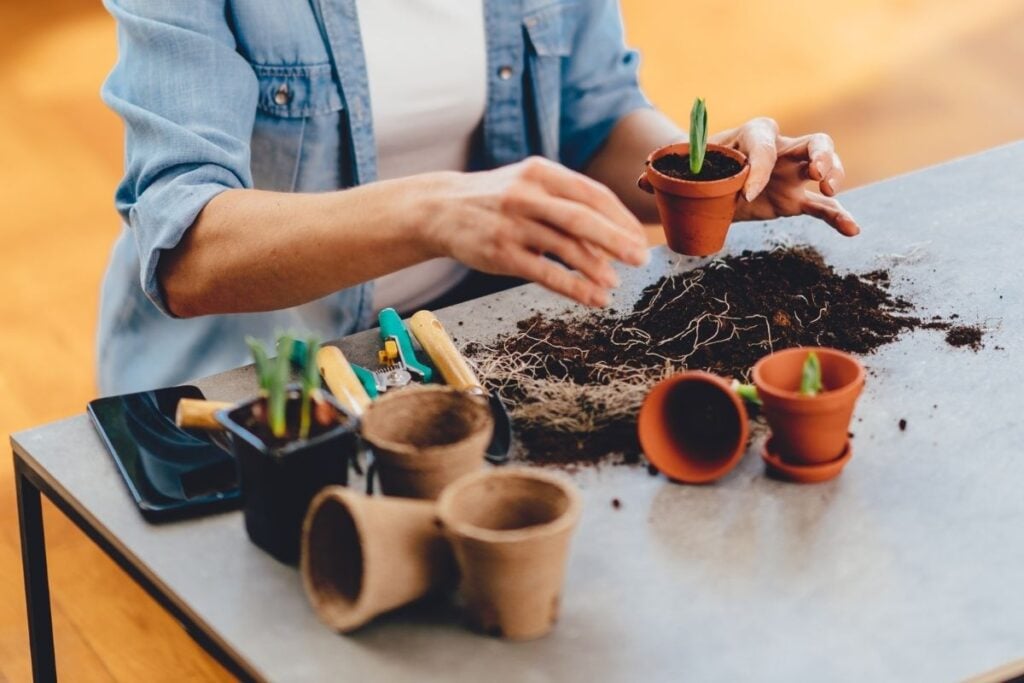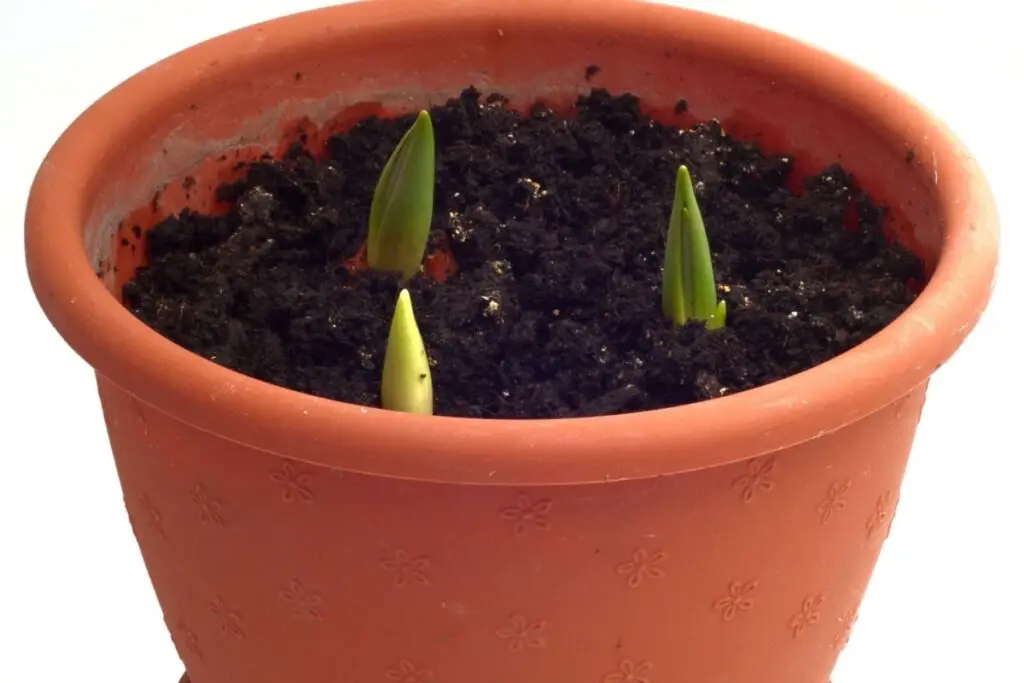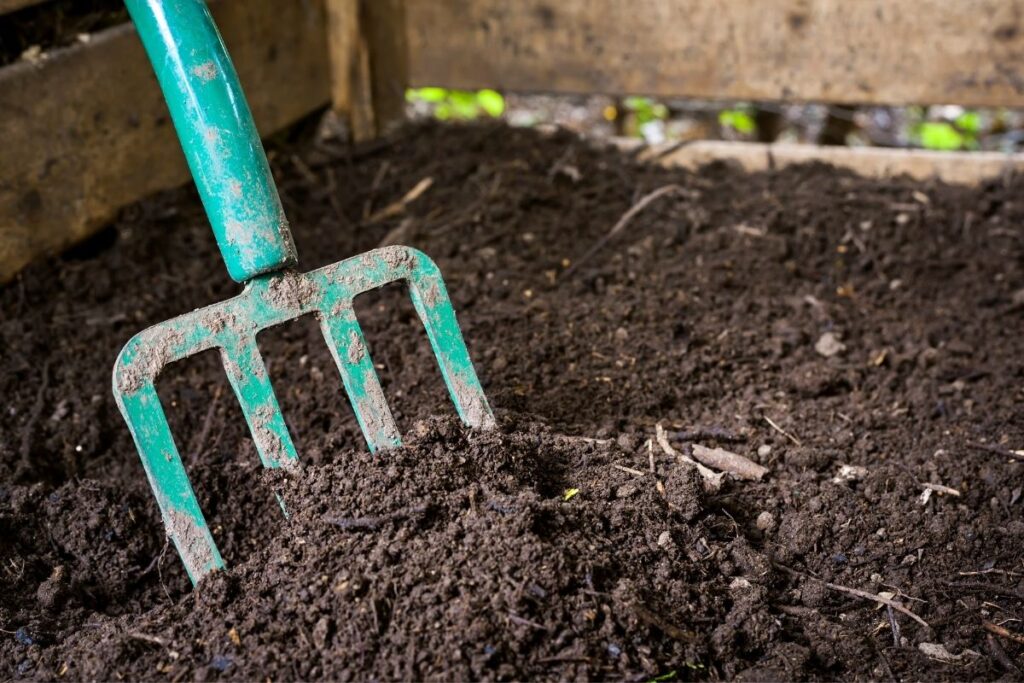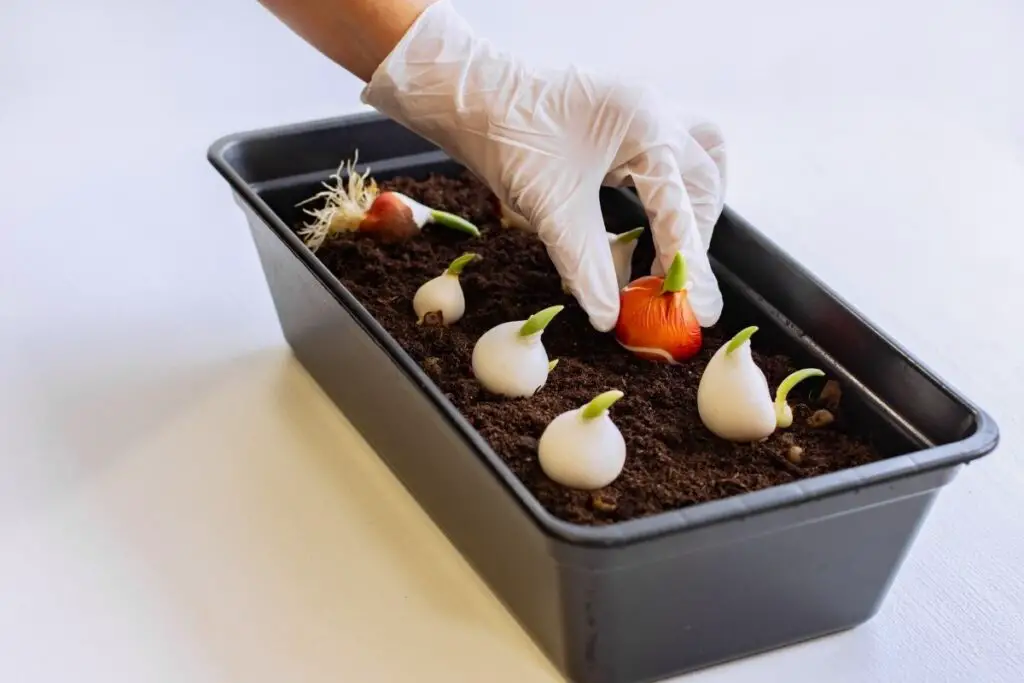The growth of your tulips depends on the soil structure. Therefore, you should be careful while picking the composition of the soil for your tulips.
So, in this article, we shall learn what kind of soil is good for tulips.
As a general rule, Tulips can be grown in any soil mix, but you must use sandy soil with lots of organic matter if you want the best results. Tulips mostly prefer neutral soil with a pH value ranging from 6.0 to 7.0. Avoid heavy garden soil, or clayey soil as that can hamper the growth of tulips.
So you must choose the soil carefully for your tulips to keep their roots healthy and strong. In this article, we will analyze the soil composition that is best for your tulips.

Importance of making the right soil choice
Tulips can grow in almost any soil, but we need to get soil with a suitable composition to get more blooms out of our tulips.
As tulips are outdoor plants, we must make sure that the soil in our garden matches the requirements of the tulips.
While selecting the composition of the soil, you need to take care of the following points:
- Always choose soil with good drainage capacity. The soil should hold up the moisture for an extended period so that the plants can absorb enough water.
- The soil should contain enough nutrients to keep the tulips healthy.
- Choose a light and loose soil so that the roots will get enough air to function correctly.
Signs that show that you are using the wrong soil mix for tulips
If the soil mix is not suitable for your tulips, the plant will show the following symptoms:
Poor growth
If you find that your tulips are growing too slow but not because of watering problems or improper sunlight, the reason might be the wrong soil composition.
If the composition of the soil is not correct, the tulips will have slow and stunted growth.
Drooping leaves
The leading cause of droopy leaves is either overwatering or under-watering. If you have used the wrong soil mix with fewer draining components, the water will not drain properly.
Due to poor drainage, the plant will sit in water for a longer period which can cause root rot, leading to droopy leaves.
Dry soil
The soil can erode if the quality is poor. It can become dusty and completely dry, making it difficult for tulips to thrive in such conditions.
Due to dry and cracked soil, the leaves can fall and wilt.
Looking for gardening supplies? We have tested 100's of products before recommending them to you guys. Check out our best pick below:
| Image | Gardening Supplies | Best Price? |
|---|---|---|
 Top
Top Top
Top | Raised Garden Bed Kit | Check On Amazon |
 | XLUX Soil Moisture Meter, Plant Water Monitor, Soil Hygrometer Sensor for Gardening, Farming, Indoor and Outdoor Plants, No Batteries Required | No Results |
 Top
Top Top
Top | 82 Pcs Garden Tools Set and Extra Succulent Tools Set | Check On Amazon |
 | Joeys Garden Expandable Garden Hose with 8 Function Hose Nozzle, Lightweight Anti-Kink Flexible Garden Hoses, Extra Strength Fabric with Double Latex Core, (50 FT, Black) | No Results |
 Top
Top Top
Top | Dual Chamber Compost Tumbler | Check On Amazon |
 Top
Top Top
Top | Sunnyglade Plant Stakes | Check On Amazon |
 Top
Top Top
Top | Organic Cold Pressed Neem Seed Oil | Check On Amazon |
 Top
Top Top
Top | Mighty Mint Gallon :-Insect and Pest Control Peppermint Oil | Check On Amazon |
 Top
Top Top
Top | Scotts DiseaseEx Lawn Fungicide | Check On Amazon |
 Top
Top Top
Top | Jacks Classic 20-20-20 All Purpose Fertilizer | Check On Amazon |
 Top
Top Top
Top | 30,000 Seeds Pollinator Attracting Wildflower Mixture | Check On Amazon |
 Top
Top Top
Top | Survival Vegetable Seeds Garden Kit-Over 16,000 Seeds | Check On Amazon |
Falling leaves
Less sand content in the soil can cause poor drainage. Due to poor drainage, the plants stay in water for days which leads to root rot problems.
Due to root rot disease, the leaves begin to droop and fall. You can change the location of the tulips by planting them in another area of the garden where the soil will be more suitable.
Soil requirements for tulips

Tulips require light and nutrition-rich sandy soil to grow in the best possible manner.
Soil mix plays a vital role in providing nutrients to the plant. Nutrients help tulips to develop a healthy root system. These strong and healthy roots help the plants to thrive and bloom.
Soil helps to keep the tulips healthy even when the climate changes.
While planting your tulips, you have to make sure the soil is:
- Loose, light, and well-draining.
- Water retention properties of the soil should be suitable.
- It should contain nutrients and other organic compost.
- The soil pH should be 6.0 to 7.0.
What kind of soil is best for tulips?
If you are planning to grow tulips in your garden, you need to make sure that the clay content in the soil is less to avoid the issue of poor drainage.
Tulips don’t like to sit in water, so if the clay content is more than the sand in the soil, it will hold water for too long, affecting their health.
Tulips require fast-draining soil and direct sunlight. So, check the soil before planting them in your garden.
The most suitable soil for tulips is soft sandy or loamy soil. Sandy soil is loose and light, which gives enough oxygen to the roots to breathe well. This soil also holds enough moisture and keeps the plant healthy.
pH level of the soil for tulips
Tulips prefer neutral or slightly acidic soil. Use a pH soil testing kit to measure the pH level of soil and maintain the pH value ranging between 6.0 and 7.0 on the pH scale.
If the soil is alkaline, you can bring them back to neutral by adding acidic mulches to the soil, including peat moss, pine needles, animal manure, and shredded oak leaves.
But if the soil is too acidic, you can maintain it by adding wood ash or limestone powder to neutralize the composition.
Best soil mix for tulips

For getting healthy and beautiful blooms, you will need to mix:
- Sand
- Peat moss
- Organic matter
- Manure compost
If you have added more clay, you can solve this problem by adding organic material to improve the heavy texture of the soil.
But only adding organic matter to the soil is not enough for your tulips. After planting, your tulips will need extra nutrients for healthy growth.
Once you have planted them, you can provide your tulips with a 10-10-10 fertilizer by covering the top inch of the soil.
Soil amendments for tulips
To get the best result from your tulips, you can amend the soil with some materials to help them grow well. These materials can help the plants remain healthy, have many blooms, and promote their growth.
There are various amendments that you can add along with the soil:
- Sand to promote good drainage.
- Coco peat to keep the soil moist for the required amount of time.
- Compost to increase water retention and to feed the plants slowly with the nutrients.
- Bone meal to provide tulips with various nutrients.
- Perlite to increase aeration and moisture retention.
- Slow release fertilizer adds nutrients like Nitrogen, Phosphorous, and Potassium.
Different types of soil mix for tulips
Various soil mixes can provide your tulips with proper drainage, enough nutrients, and proper air circulation among the roots.
Type 1
Use a mixture of organic matter with sand, peat moss, and compost. Mix:
- 30% of potting soil
- 30% of compost
- 20% of peatmoss
- 20% of sand
This mixture helps the tulips thrive as it can hold moisture for a more extended period and provides good drainage to the plant. This soil mix doesn’t stay soggy even during heavy rainfalls and overwatering issues.
Ingredients like manure compost and peat moss provide enough nutrients to the tulips and improve their growth.
Type 2
Another type is, you can mix worm casting in the sandy soil with some micronutrients and fertilizers. To get healthy and beautiful blooms, you can add:
- 40% of potting soil
- 30% sand
- 10% perlite
- 20% compost
- A Handful of bonemeal
Sometimes the mix can be complicated, but this provides the best result for your tulips and encourages the plants to grow healthy with beautiful blooms.
You can also provide slow-acting fertilizers after planting your tulips. These fertilizers provide a small amount of nutrients from time to time without causing the issue of over-fertilization.
Slow-release fertilizers also reduce the chances of burns in tulips, so it is best to provide this fertilizer.
Soil temperature for tulips
Tulips mostly thrive in cool temperatures. You should plant your tulips in the late fall because the soil temperatures stay below 60°F during that time.
During extreme temperatures, mulch your tulips with organic materials to protect them.
Mulch at least 2 to 3 inches at the top to keep the soil temperature cool. Always protect your plant from high temperatures as they mostly flourish when the soil is cool and well-draining.
You can also plant tulips during spring.
During this season, you should always choose soil that has a fast-draining capacity as it becomes too difficult for soil to dry out after watering and mostly stay wet when the winter arrives. Always plant tulips in full sun.
Do tulips need deep digging?
The depth of the soil depends on climatic conditions. If the climate is already cold, you should dig the soil 4 to 6 inches deep, but if the climate is warm, you should dig 8 to 10 inches to protect the tulips from warmer conditions.
If the soil is deep, it protects the plants from various conditions like extreme heat, cold drafts, heavy rain, and wind and prevents the plants from being damaged. The suitable soil depth to grow tulips is 4 to 6 inches, making sure the soil is light.
When to plant your tulips?

The best time to plant your tulip bulbs is during fall, when the temperature slightly cools off after the summer season.
You can plant them in September when the weather is cold, in October where the weather is relatively intermediate or transitional, and in November or December where the weather is warm.
After deciding when to plant, you have to decide the suitable spot where these plants will thrive. Choose a spot where your tulips will get direct sunlight throughout the day.
Dig the soil 6 to 8 inches deep and add prepared soil mix before planting your tulips. After that, put the tulips in the hole, cover the hole with the soil, and gently press the soil firmly to remove the air bubbles.
After planting, water your tulips so that the roots can adjust to the soil by absorbing the water.
When to divide your tulips?
You should divide your tulips after 3 to 5 years before they begin to die. Divide your tulips between the midsummer or mid-fall when all the blooms die entirely.
Before dividing the tulips, you need first to choose a spot in your garden. Dig the soil 8 inches deep and use organic soil mix and slow-release fertilizer.
For dividing your tulips, use a shovel to dig 8 inches carefully inside the soil. While digging, make sure you don’t damage the roots of the tulips.
When you notice that the roots have loosened up, gently pull them out from the ground.
Choose the plants with healthy roots and then plant them in the chosen area of the garden. Add all the organic matter to the soil and cover the hole. After the process is done, water your plants thoroughly to fill the soil with moisture.
Final words
Tulips love soil with good drainage that can hold enough moisture in direct sunlight. While growing your tulips in your garden, add enough sandy soil. Always maintain a neutral pH level of the soil. It should not be too acidic or alkaline.
Prune off dead and old flowers to encourage the tulips to bloom more.
When the sun is too harsh on tulips, mulch the surface to protect the plants from extreme heat and keep the soil moist enough.
Source: Wikipedia, North Dakota Stae University, The Royal Horticultural Society.
